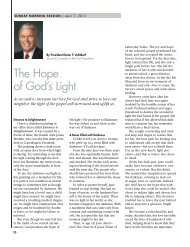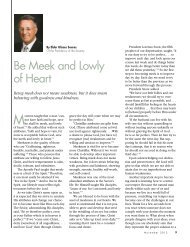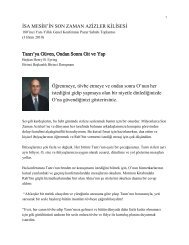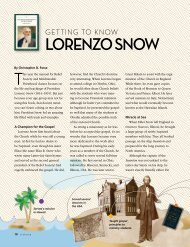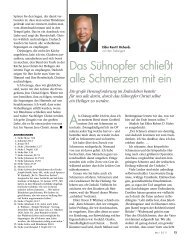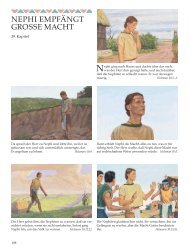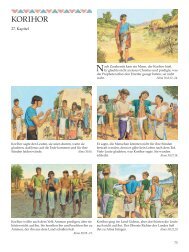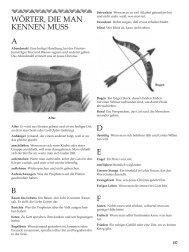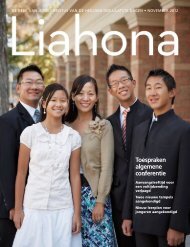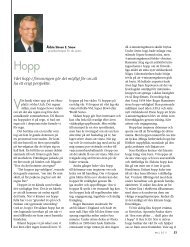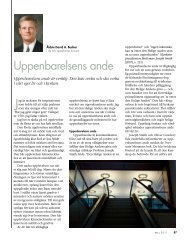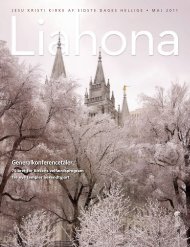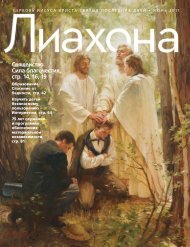Ensign, Nov. 2007 - The Church of Jesus Christ of Latter-day Saints
Ensign, Nov. 2007 - The Church of Jesus Christ of Latter-day Saints
Ensign, Nov. 2007 - The Church of Jesus Christ of Latter-day Saints
Create successful ePaper yourself
Turn your PDF publications into a flip-book with our unique Google optimized e-Paper software.
40<br />
<strong>The</strong> Only True God<br />
and <strong>Jesus</strong> <strong>Christ</strong><br />
Whom He Hath<br />
Sent<br />
ELDER JEFFREY R. HOLLAND<br />
Of the Quorum <strong>of</strong> the Twelve Apostles<br />
We declare it is self-evident from the scriptures<br />
that the Father, the Son, and the Holy Ghost<br />
are separate persons, three divine beings.<br />
As Elder Ballard noted earlier<br />
in this session, various crosscurrents<br />
<strong>of</strong> our times have<br />
brought increasing public attention to<br />
<strong>The</strong> <strong>Church</strong> <strong>of</strong> <strong>Jesus</strong> <strong>Christ</strong> <strong>of</strong> <strong>Latter</strong><strong>day</strong><br />
<strong>Saints</strong>. <strong>The</strong> Lord told the ancients<br />
this latter-<strong>day</strong> work would be “a marvellous<br />
work and a wonder,” 1 and it is.<br />
But even as we invite one and all to<br />
examine closely the marvel <strong>of</strong> it,<br />
there is one thing we would not like<br />
anyone to wonder about—that is<br />
whether or not we are “<strong>Christ</strong>ians.”<br />
By and large any controversy in<br />
this matter has swirled around two<br />
doctrinal issues—our view <strong>of</strong> the<br />
Godhead and our belief in the principle<br />
<strong>of</strong> continuing revelation leading to<br />
an open scriptural canon. In addressing<br />
this we do not need to be apologists<br />
for our faith, but we would like<br />
not to be misunderstood. So with a<br />
desire to increase understanding and<br />
unequivocally declare our <strong>Christ</strong>ianity,<br />
I speak to<strong>day</strong> on the first <strong>of</strong> those two<br />
doctrinal issues just mentioned.<br />
Our first and foremost article <strong>of</strong><br />
faith in <strong>The</strong> <strong>Church</strong> <strong>of</strong> <strong>Jesus</strong> <strong>Christ</strong><br />
<strong>of</strong> <strong>Latter</strong>-<strong>day</strong> <strong>Saints</strong> is “We believe in<br />
God, the Eternal Father, and in His<br />
Son, <strong>Jesus</strong> <strong>Christ</strong>, and in the Holy<br />
Ghost.” 2 We believe these three<br />
divine persons constituting a single<br />
Godhead are united in purpose, in<br />
manner, in testimony, in mission. We<br />
believe <strong>The</strong>m to be filled with the<br />
same godly sense <strong>of</strong> mercy and love,<br />
justice and grace, patience, forgiveness,<br />
and redemption. I think it is<br />
accurate to say we believe <strong>The</strong>y are<br />
one in every significant and eternal<br />
aspect imaginable except believing<br />
<strong>The</strong>m to be three persons combined<br />
in one substance, a Trinitarian notion<br />
never set forth in the scriptures<br />
because it is not true.<br />
Indeed no less a source than the<br />
stalwart Harper’s Bible Dictionary<br />
records that “the formal doctrine <strong>of</strong><br />
the Trinity as it was defined by the<br />
great church councils <strong>of</strong> the fourth<br />
and fifth centuries is not to be found<br />
in the [New Testament].” 3<br />
So any criticism that <strong>The</strong> <strong>Church</strong> <strong>of</strong><br />
<strong>Jesus</strong> <strong>Christ</strong> <strong>of</strong> <strong>Latter</strong>-<strong>day</strong> <strong>Saints</strong> does<br />
not hold the contemporary <strong>Christ</strong>ian<br />
view <strong>of</strong> God, <strong>Jesus</strong>, and the Holy<br />
Ghost is not a comment about our<br />
commitment to <strong>Christ</strong> but rather a<br />
recognition (accurate, I might add)<br />
that our view <strong>of</strong> the Godhead breaks<br />
with post–New Testament <strong>Christ</strong>ian<br />
history and returns to the doctrine<br />
taught by <strong>Jesus</strong> Himself. Now, a word<br />
about that post–New Testament history<br />
might be helpful.<br />
In the year A.D. 325 the Roman<br />
emperor Constantine convened the<br />
Council <strong>of</strong> Nicaea to address—among<br />
other things—the growing issue <strong>of</strong><br />
God’s alleged “trinity in unity.” What<br />
emerged from the heated contentions<br />
<strong>of</strong> churchmen, philosophers, and<br />
ecclesiastical dignitaries came to be<br />
known (after another 125 years and<br />
three more major councils) 4 as the<br />
Nicene Creed, with later reformulations<br />
such as the Athanasian Creed.<br />
<strong>The</strong>se various evolutions and iterations<br />
<strong>of</strong> creeds—and others to come<br />
over the centuries—declared the<br />
Father, Son, and Holy Ghost to be<br />
abstract, absolute, transcendent,<br />
imminent, consubstantial, coeternal,<br />
and unknowable, without body, parts,<br />
or passions and dwelling outside<br />
space and time. In such creeds all<br />
three members are separate persons,<br />
but they are a single being, the



